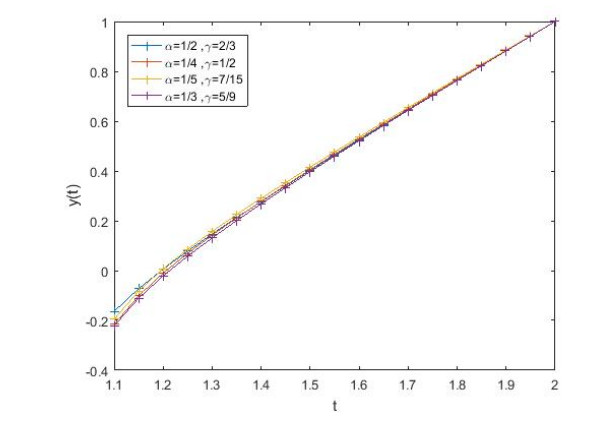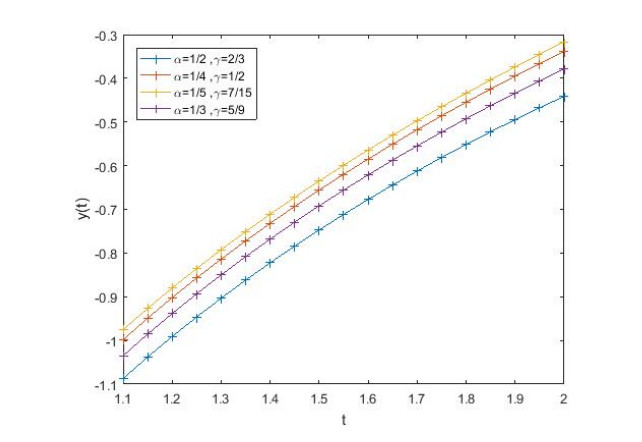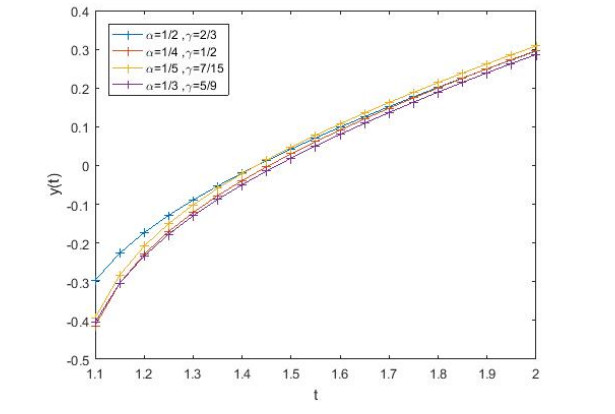In this paper, we prove the existence and uniqueness of solutions of a new class of boundary value problems of terminal type for ψ-Hilfer fractional differential equations. The technique used in the analysis relies on the Banach contraction principle and Krasnosleskii fixed point theorem. Moreover, we use generalized Gronwall inequality with singularity to establish uniqueness and continuous dependence of the δ-approximate solution. Finally, we demonstrate some examples to illustrate our main results.
1.
Introduction
In the recent years, scientific community renders more attention on fractional differential equations, since their are effective tools in modeling many phenomena in applied sciences and engineering application such as acoustic control, rheology, polymer physics, porous media, medicine, electrochemistry, proteins, electromagnetics, economics, astrophysics, chemical engineering, signal processing, optics, chaotic dynamics, statistical physics and so on for more details, see [1,2,3,4]. Since boundary value problems of fractional differential equations represent an important class of applied analysis, therefore the said area was given more importance, see [5,6,7,8,9,10] and references therein.
Terminal value problems for differential equation nowadays play an essential part in the modeling of numerous phenomena in physical science, engineering, and so forth. Also, it arise naturally in the simulation of techniques that are watched at a later point, eventually after the methodology has started.
Existence theory for classical terminal value problems have been investigated by several researchers [11,12,13,14,15,16,17,18,19,20,21,22]. It is well known [23] that the comparison principle for initial value problems of ordinary differential equations is a very useful tool in the study of qualitative and quantitative theory. Recently, attempts have been made to study the corresponding comparison principle for terminal value problems (TVP) [24]. Benchohra et. al. [14], studied the existence results and uniqueness of solutions for a class of boundary value problems of terminal type for fractional differential equations with the Hilfer–Katugampola fractional derivative by using different types of classical fixed point theory such as the Banach contraction principle and Krasnoselskii's fixed point theorem.
Motivated by the above-mentioned works, the objective of this work is to study conditions for the existence and uniqueness of the solutions for terminal value problem for fractional differential equations of the type
where Dα,β;ψa+(⋅) is the ψ-Hilfer fractional derivative of order α∈(0,1), type β∈[0,1] and f:(a,T]×R×R→R is a given function. Moreover, we study the uniqueness and continuous dependence of the δ-approximate solution by generalized Gronwall inequality. To our knowledge, no papers on terminal value problem for implicit fractional differential equations exist in the literature, in particular for those involving the ψ-Hilfer fractional derivative.
The rest of the paper is organized as follows. In section 2, we present some necessary definitions and results which are used throughout this paper. In section 3, we study the existence and uniqueness results of ψ-Hilfer fractional differential equation with the terminal condition by using some fixed point theorems such as Banach and Krasnoselskii. In section 4, we study the δ-approximate solution of the problem (1.1), (1.2). Also, four examples are included to illustrate the applicability of the results obtained.
2.
Preliminaries
In this section, we recall some notations, definitions of the fractional differential equation which are using throughout this paper. Let [a,T]⊂R+ with (0<a<T<∞), and let C[a,T] be the Banach space of continuous function y:[a,T]→R with the norm ‖y‖C[a,T]=max{|y(t)|:a≤t≤T}. The weighted space C1−γ;ψ[a,T] of continuous function y is defined by [25]
Obviously, C1−γ;ψ[a,T] is a Banach space endowed with the norm
Definition 2.1. [26] Let α>0, y∈L1[a,b] and ψ∈C1[a,b] be an increasing function with ψ′(t)≠0, for all t∈[a,b]. Then, the left-sided ψ-Riemann-Liouville fractional integral of a function y is defined by
where Γ(⋅) is the Euler gamma function defined by Γ(α)=∫∞0sα−1e−sds, α>0.
Definition 2.2. [27] Let n−1<α<n, ( n=[α]+1), and y,ψ∈Cn[a,b] be two functions with an increasing ψ and ψ′(t)≠0, for all t∈[a,b]. Then, the left-sided ψ-Riemann-Liouville fractional (ψ-Caputo) derivative of a function y of order α is defined by
and
respectively.
Definition 2.3. [25] Let n−1<α<n, ( n∈N), and y,ψ∈Cn[a,T] be two functions such that ψ is increasing and ψ′(t)≠0, for all t∈[a,T]. Then, the left-sided ψ-Hilfer fractional derivative of a function y of order α and type 0≤β≤1 is defined by
In this paper we consider the case n=1, because 0<α<1.
Lemma 2.4. [2] Let α>0 and 0≤γ<1. Then Iα,ψa+ is bounded from C1−γ;ψ[a,b] into C1−γ;ψ[a,b].
Now, we introduce the following spaces
and
Lemma 2.5. [25] Let γ=α+β−αβ where α∈(0,1), β∈[0,1], and y∈Cγ1−γ;ψ[a,T]. Then
and
Lemma 2.6. [25] Let α>0, 0≤γ<1 and y∈C1−γ[a,T], β∈[0,1]. Then
Lemma 2.7. [2] Let t>a. Then for α≥0 and γ>0, we have
and
Lemma 2.8. [25] Let γ=α+β−αβ where α∈(0,1), β∈[0,1], y∈Cγ1−γ;ψ[a,T] and I1−γ;ψa+y∈C11−γ,ψ[a,T]. Then, we have
Lemma 2.9. [25] Let α>0,0≤γ<α and y∈C1−γ,ψ[a,T] (0<a<T<∞). If γ<α, then Iα;ψa+:C1−γ,ψ[a,T]→C1−γ,ψ[a,T] is continuous on [a,T] and satisfies
Theorem 2.10. [28] (Krasnoselskii fixed point theorem). Let M be closed, convex, bounded and nonempty subset of a Banach space X and A,B be two operators such that
(1) Au+Bv∈M for all u,v∈M.
(2) A is compact and continuous.
(3) B is contraction mapping.
Then there exists z∈M such that z=Az+Bz.
Theorem 2.11. [29] (Banach's fixed point theorem). Let X be a Banach space and M be a nonempty closed subset of X, then any contraction mapping T:M→M has a unique fixed point.
Lemma 2.12. [30] (Generalized Gronwall's Inequality Lemma) Let α>0 and x,y be two nonnegative function locally integrable on [a,b]. Assume that g is nonnegative and nondecreasing, and let ψ∈C1[a,b] be an increasing function such that ψ′(t)≠0 for all t∈[a,b]. If
then
If y be a nondecreasing function on [a,b], then
where Eα(⋅) is the Mittag-Leffler function defined by
3.
Existence of solutions
Theorem 3.1. Let γ=α+β−αβ, where α∈(0,1) and β∈[0,1]. If f:(a,T]→ R is a function such that f(⋅)∈C1−γ,ψ[a,T], then y∈Cγ1−γ,ψ(a,T] satisfies the following problem
if and only if y satisfies the following integral equation
Proof. First, let y∈Cγ1−γ,ψ(a,T] be a solution of the problem (3.1), (3.2). We prove that y is also a solution of Eq (3.3). From the definition of Cγ1−γ,ψ(a,T], Lemma 2.4, and using the definition 2.3, we have
By the definition of the space Cn1−γ,ψ[a,T], it follows that
Using Lemma 2.8, with α=γ, we obtain
Since y∈Cγ1−γ,ψ[a,T], and using Lemma 2.5 with Eq (3.1), we have
Comparing Eqs (3.5) and (3.6), we see that
Using Eq (3.2), we get
Hence y(t) satisfies the problem (3.1), (3.2).
Conversely, Let y∈Cγ1−γ,ψ[a,T] be a function satisfying Eq (3.3). We prove that y is also a solution of the problem (3.1), (3.2). Apply the operator Dγ;ψa+ on both sides of Eq (3.3). Then, from Lemmas 2.7 and 2.5, we have
From Eq (3.4), we have Dγ;ψa+y∈C1−γ;ψ[a,T], and hence, Eq (3.8) implies
As f(t)∈C1−γ;ψ[a,T], and from Lemma 2.4, it follows that
From Eqs (3.9) and (3.10) and the definition of the space Cn1−γ;ψ(a,T], we get
Now, by applying operator Iβ(1−α);ψa+ on both sides of Eq (3.9) and using Lemmas 2.9, 2.8, we have
From Eq (2.1), the Eq (3.11) reduces to
that is, Eq (3.1) holds.
Before given our main results, the following conditions must be satisfied
H1 f:(a,T]×R×R→R is continuous function such that f(⋅,x(⋅),y(⋅))∈Cβ(1−α)1−γ;ψ for all x,y∈C1−γ;ψ[a,T].
H2 There exist two constants L>0 and M∈(0,1) such that
for all x1,y1,x2,y2∈R and t∈(a,T].
In the forthcoming theorem, by using the Banach fixed point theorem, we prove the unique solution of the problem (1.1), (1.2)
Theorem 3.2. Assume that (H1) and (H2) hold. If
then the problem (1.1), (1.2) has a unique solution in Cγ1−γ;ψ[a,T]⊂Cα,β1−γ;ψ[a,T].
Proof. In view of Theorem 3.1, the solution of the problem (1.1), (1.2) is given by
where Ky(t)=f(t,y(t),Ky(t)). Consider the operator F:C1−γ;ψ[a,T]→C1−γ;ψ[a,T] defined by
by Lemma 2.4, we deduce that Fy∈C1−γ;ψ[a,T]. The proof will be given in two steps
Step(1): We show that the operator F has a unique fixed point ˆy in C1−γ;ψ[a,T]. Let y,y∗∈C1−γ;ψ[a,T] and t∈(a,T]. Then, we have
where Ky(s),Ky∗(s)∈C1−γ;ψ[a,T] such that
By (H2), we have
which implies
Then for any t∈(a,T], we have
In view of Lemma 2.7, we obtain
Hence
which implies that
Due to Eq (3.12), we deduce that the operator F is a contraction mapping. According to Banach's contraction principle, we conclude that F has a unique fixed point ˆy∈C1−γ;ψ[a,T].
Step(2): We show that such a fixed point ˆy∈C1−γ;ψ[a,T] is actually in Cγ1−γ;ψ(a,T]. Since ˆy is the unique fixed point of F in C1−γ;ψ[a,T], then, for each t∈(a,T], we have
Multiplying both sides of the last equation by Dγ,ψa+, using Lemmas 2.7 and 2.5, we have
Since γ≥α, by (H1), we have Dβ(1−α);ψa+Kˆy(t)∈C1−γ;ψ[a,T], and hence Dγ,ψa+ˆy∈C1−γ;ψ[a,T]. It follows from definition of Cγ1−γ;ψ[a,T] that ˆy∈Cγ1−γ;ψ[a,T]. As a consequence of the above steps, we conclude that the problem (1.1), (1.2) has a unique solution in Cγ1−γ;ψ[a,T].
We present now the second result, which is based on Krasnoselskii fixed point theorem.
Theorem 3.3. Assume that (H1) and (H2) hold. Then the problem (1.1), (1.2) has at least one solution in Cγ1−γ;ψ[a,T].
Proof. Defined the closed, bounded, convex and nonempty set
with
Set N=supt∈(a,T]|f(t,0,0)|. We split the operator F which defined by Eq (3.14) into two operators F1,F2 in kξ as following
and
Note that Fy(t)=F1y(t)+F2y(t). The proof will be divided into several steps as follows:
Step(1):We show that F1y(t)+F2v(t)∈kξ for any y,v∈kξ.
(ⅰ) For t∈(a,T] and y∈kξ, we have
From (H2), we have
Multiplying both sides of the last inequality by (ψ(t)−ψ(a))1−γ, we get
Then, for each t∈(a,T], we have
Thus, the Eq (3.16) and Lemma 2.7, imply that
(ⅱ) In a similar manner, for t∈(a,T], v∈kξ, we get
Linking Eqs (3.17) and (3.18), for any y,v∈kξ, we obtain
which implies that F1y(t)+F2v(t)∈kξ.
Step(2): We show that F1 is a contraction mapping. From Theorem 3.2, we have already proved that F is a contraction mapping and hence F1 is a contraction mapping too in kξ.
Step(3): We show that F2 is a compact and continuous in kξ.
The continuity of F2 follows from the continuity of f. Now, we need only to prove that F2 is compact (i.e F2 uniformly bounded and equicontinuous). From Eq (3.18), for any v∈kξ, we have
This means that F2 is uniformly bounded in kξ. Next, we show that F2 is equicontinuous in kξ. Let y∈kξ and t1,t2∈(a,T] such that t1<t2. Then, we have
This means that \mathcal{F}_{2} is equicontinuous in \mathcal{\Bbbk } _{\xi }. Hence \mathcal{F}_{2} is relatively compact on \mathcal{\Bbbk } _{\xi }. By Arzelá-Ascoli Theorem, we deduce that \mathcal{F}_{2} is compact on \mathcal{\Bbbk }_{\xi }. According to Theorem (2.10), we conclude that \mathcal{F} has at least a fixed
point \widehat{y}\in C_{1-\gamma; \psi }\left[a, T\right] and by the same way of the proof of Theorem 3.2, we can easily show that \widehat{y}
\in C_{1-\gamma; \psi }^{\gamma }\left[a, T\right]. Thus the problem (1.1), (1.2) has at least one solution in C_{1-\gamma; \psi }^{\gamma }
\left[a, T\right] .
4.
\delta -Approximat solution
Definition 4.1 A function y\in C_{1-\gamma, \psi }^{\gamma }\left[a, T \right] satisfying the \psi -Hilfer implicit fractional differential inequality
and
is called \delta -approximate solutions of \psi -Hilfer implicit fractional differential (1.1), (1.2)
Theorem 4.2. Let f:\left(a, T\right] \times
\mathbb{R}
\times
\mathbb{R}
\rightarrow
\mathbb{R}
be a continuous function satisfies the condition (H _{2} ) for each t\in J and. Let z_{i}\in C_{1-\gamma, \psi }^{\gamma }\left(a, T\right], i = 1, 2, be a \delta -approximation solutions of the following \psi
-Hilfer implicit fractional differential equation
Then
where
Proof. Let z_{i}\in C_{1-\gamma, \psi }^{\gamma }\left(a, T\right], i = 1, 2, be an \delta -approximation solutions of the problem (4.2). Then, we have
and
Applying I_{a^{+}}^{\alpha, \psi } on both sides of the above inequality, and using lemma 2.8, we get
Using the fact \left\vert x\right\vert -\left\vert y\right\vert \leq \left\vert x-y\right\vert \leq \left\vert x\right\vert +\left\vert y\right\vert in the above inequality, we have
In consequence, we have
where
Using Lemma 2.12, we obtain
Hence for each t\in \left[a, b\right], we have
Thus
Remark 4.3 If \delta _{1} = \delta _{2} = 0 in the inequality (4.3), then z_{1}, z_{2} are solutions of the problem (1.1) and the inequality (4.4) reduces to
which provides the continuous dependence of the problem (1.1). Also if w_{1}^{\ast } = w_{2}^{\ast }, we have \left\Vert z_{1}-z_{2}\right\Vert _{C_{1-\gamma, \psi }} = 0, which provides the uniqueness of a solution of problem (1.1).
5.
Examples
In this section, we present illustrative examples to validate our results.
Example 5.1. Consider the following terminal value problem
Set f(t, u, v) = \frac{t}{10}\left(1+u+v\right), for each u, v\in \mathbb{R}
, t\in \left(1, 2\right],
with \alpha = \frac{1}{2}, \beta = 0, \gamma = \frac{1}{2}, \psi (t) = e^{t},
\left(a, T\right] = \left(1, 2\right], K_{y}(t) = f(t, y(t), K_{y}(t)). Clearly, the function f\in C_{\frac{1}{2};e^{t}}\left[1, 2\right] . Hence condition ( H_{1} ) is satisfied. For u, v, u^{\ast }, v^{\ast }\in \mathbb{R}
, t\in \left(1, 2\right], we have
Hence the hypothesis ( H_{2} ) is satisfied with M = L = \frac{1}{10e}. By some simple calculations, the condition:
is satisfied with T = 2 and a = 1 . Thus all assumptions in Theorem 3.2 are satisfied. It follows from Theorem 3.2 that the problem (5.1) has a unique solution in C_{\frac{1}{3};e^{t}}^{\frac{1}{2}}[1,2].
Example 5.2 Consider the following terminal value problem
Set f(t, u, v) = \frac{1}{20e^{e+1-t}}\left(\ln t^{\frac{1}{2}}\cos u+v\right), for each u, v\in \mathbb{R}
, t\in \left(1, e\right],
with \alpha = \frac{1}{2}, \beta = 0, \gamma = \frac{1}{2}, \psi (t) = \ln t,
\left(a, T\right] = \left(1, e\right]. Clearly, the function f\in C_{\frac{ 1}{2};\ln t}\left[1, e\right] . Hence condition ( H_{1} ) is satisfied. For u, v, u^{\ast }, v^{\ast }\in \mathbb{R}
, t\in \left(1, e\right], we have
Hence the hypothesis ( H_{2} ) is satisfied with M = L = \frac{1}{20e}. By some simple calculations, the condition:
is satisfied with with T = e and a = 1 . Thus all assumptions in Theorem 3.2 are satisfied. It follows from Theorem 3.2 that the problem (5.2) has a unique solution in C_{\frac{1}{2};\ln t}^{\frac{1}{2}}\left[1, e\right].
Example 5.3 Consider the following terminal value problem
Set f(t, u, v) = \frac{1}{10}\left(t^{2}\cos u+v\right), for each u, v\in \mathbb{R}
, t\in \left(1, 2\right],
with \alpha = \frac{1}{2}, \beta = 0, \gamma = \frac{1}{2}, \psi (t) = t^{\rho }
(\rho = \frac{1}{2}), \left(a, T\right] = \left(1, 2\right]. Clearly, the function f\in C_{\frac{1}{2};t^{\rho }}\left[1, 2\right] . Hence condition ( H_{1} ) is satisfied. For u, v, u^{\ast }, v^{\ast }\in \mathbb{R}
, t\in \left(1, 2\right], we have
Hence the hypothesis ( H_{2} ) is satisfied with M = L = \frac{1}{10}. By some simple calculations, the condition:
is satisfied with \rho = \frac{1}{2} T = 2 and a = 1 . Thus all assumptions in Theorem 3.2 are satisfied. It follows from Theorem 3.2 that the problem (5.3) has a unique solution in C_{\frac{1}{2};t^{\rho }}^{
\frac{1}{2}}\left[1, 2\right].
Example 5.4 Consider the following terminal value problem
By Theorem 3.1, the implicit solution of problem (5.4) is given by
Here, we consider K_{y}(t) = f(t, y(t), K_{y}(t)) = 1, w = 1, a = 1\ and T = 2 .
Case (ⅰ) If \psi (t) = t, the exact solution of problem (5.4) is defined by
Case (ⅱ) If \psi (t) = \log t, the exact solution of problem (5.4) is defined by
Case (ⅲ) If \psi (t) = t^{\rho }, \rho > 0, the exact solution of problem (5.4) is defined by
Figure 1, presents the solution curves with some values of \alpha and
\gamma , when \psi (t) = t. Figure 2, presents the solution curves with some values of \alpha and \gamma , when \psi (t) = log(t). Figure 3, presents the solution curves with some values of \alpha and \gamma , when \psi (t) = t^{\rho}.
6.
Conclusions
We have provided sufficient conditions ensuring the existence and uniqueness of solutions to a class of terminal value problem for differential equations with the \psi -Hilfer type fractional derivative. The arguments are based on the classical Banach contraction principle, and the Krasnoselskii's fixed point theorem. Moreover, we used generalized Gronwall inequality with singularity to established uniqueness and continuous dependence of the
\delta -approximate solution. Four examples are included to show the applicability of our results.
Conflict of interest
All authors declare no conflicts of interest.










 DownLoad:
DownLoad:





